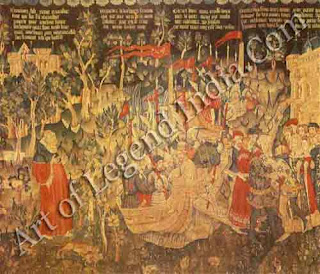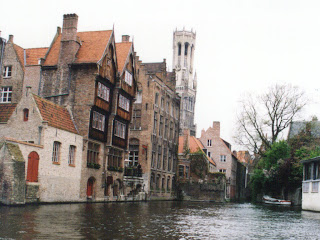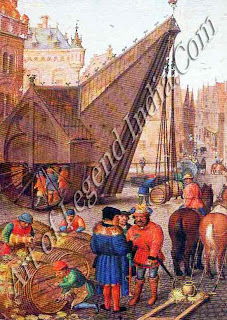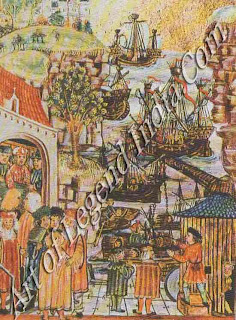Netherlandish Great Artist Jan Van Eyck - The Port of Bruges
Posted by
Art Of Legend India [dot] Com
On
2:04 AM
Now a
town of quiet tree-lined canals and fine medieval architecture, Bruges once led
a very different life it was the trading centre of the whole of north-west
Europe.
On a
January day in 1430, the Flemish city of Bruges was on its best behaviour.
Thousands of its citizens lined the narrow streets, jostling and straining to
catch a glimpse of the Princess Isabella of Portugal as she passed by. She had
arrived from her homeland to be with her future husband, Duke Philip the Good
of Burgundy.
Among
the Duke's enormous entourage that day was no less than 40 varlets de chamber.
One of them was Jan van Eyck. For the last part of his life, Van Eyck was based
in Bruges, a port on the Zwijn River, almost 10 miles inland from the North Sea.
His works helped to characterize the city as the cradle of Flemish painting.
But Bruges had already won an enviable reputation as a major centre of the
medieval cloth industry, and as the main international emporium of north-west
Europe.
As one
French chronicler noted, when describing that royal entry of 1430, Bruges was
'thronged with visitors from foreign lands . . . a centre for merchandise and a
meeting-place for those of other lands, where pass greater quantities of goods
than, perchance, in any other city of Europe'. The chronicler added, 'and a
great shame it would be if ever Bruges were destroyed. .
In
subsequent centuries Bruges declined, but it never was destroyed. Thus the city
of Van Eyck's era has not completely disappeared from view. Many of the homes
of the medieval bourgeoisie are still standing tall, thin houses, mostly built
of brick, subtly decorated with pink or grey sandstone, white stone from
Brabant or blue Tournai limestone. Their large rooms are lit by spacious
windows, which once allowed the householder's prized oil paintings to be seen
to their best advantage. The old Market Hall can still be identified from afar
by its distinctive belfry. The Town Hall, the Church of Notre Dame and the
Beguinage a retreat for secular nuns all survives to recall the city's former
prosperity.
Yet
this tangible legacy can easily mislead. The quiet canals and the dignified
Gothic architecture create an atmosphere of tranquillity, even of serenity. But
this belies the turmoil of the city's early history, when its citizens fiercely
resisted the efforts of Flemish counts and French kings to subdue them; in
their halcyon days the Three Members from Flanders' Bruges, Ghent and Ypres
virtually governed the province between them. Bruges was no quaint medieval
backwater. It was a tumultuous commercial city, where merchants from 17 nations
operated, and 20 states were represented by official ministers.
In
medieval times, the continent comprised two main commercial zones that of the
Baltic and the North Sea, and that of the Mediterranean. Bruges began to
prosper as a textile centre within the northern zone, and also as a convenient
port for the commercial traffic between England and Flanders. As the Flemish
cloth industry came to rely more and more heavily on English supplies of wool,
so the trade of Bruges expanded rapidly.
The
port then evolved into something far more than a simple Anglo-Flemish trade
junction. Germans, Normans, Bretons and Spaniards came in increasing numbers to
buy and sell at Bruges's annual fair, established in 1200. Before the end of
the 13th century, the great galleys of Genoa and Venice were heading regularly
for the northern port. So at a time when land communications were unreliable,
Bruges became the destination of seaborne merchants from both the northern and
southern commercial centres of Europe.
The
native Flemings did not themselves develop as international merchants. Instead,
the foreign community of Bruges grew larger and it became a truly cosmopolitan
city. Its prosperity came to rely not on intermittent fairs, but on permanent
trade. Merchandise was sent there for distribution in all directions and the
commodities which found their way on to the quayside came from around the
world. There were Russian furs, northern cloths, wines from Burgundy, Bordeaux
and the Rhine, and metals from Germany. There was wool, tin and cheeses from
England, butter and pigs from Denmark, corn from Prussia, and salt fish and
dried fish from Norway. And there was Baltic timber in abundance, and fruit
from Spain. Perhaps the most exotic goods were those stocked in the warehouses
of the spice-importers, cinnamon from Ceylon, cloves from the Molucca Islands,
mace from Arabia not forgetting the saffron, cinnabar, ivory and oil of white
poppy which were used as artists' materials.
Such a
thriving commercial centre naturally attracted businessmen. By 1369 there were
15 separate 'merchant banks' there. Italian bankers and money-lenders were keen
to establish their northern branches in the city. In 1469, the Medici of
Florence had a staff of eight at Bruges, one of whom was responsible for
purchases of cloth and wool, while another had the duty of selling silks and
velvets to the Burgundian court. Giovanni Arnolfini, whose wedding portrait was
painted by Van Eyck, was himself an Italian expatriate from Lucca. He was one
of the leading importers of alum, a substance essential for the dyeing of wool.
Germans
as well as Italians found the city to be a profitable home-from-home. Bruges
was one of the Hanseatic League's overseas trading posts, along with London,
Bergen and Novgorod. The League had been formed by German merchants to give
political backing to their trading agreements. The trading posts, or kontore,
were independent from their host country. Within them, members were under the
jurisdiction of German law; houses, offices and warehouses were all corporately
owned and here the League members lived and traded.
Communities
of foreign merchants at this time, were often encouraged to live in a
particular area of a city, separate from the native citizens. In Bruges,
however, the Hanseatic League were not confined to specific quarters of the
city but lived among the Flemings. Elsewhere in northern Europe, these
privileged German League communities often encountered native resentment, but
their kontore was welcomed in Bruges and seen as a source of extra trade and
revenue, increasing the city's prosperity.
A large
proportion of the citizens, however, did not share in the general affluence.
They had to endure the rigours and squalor of medieval urban life as best they
could. 'This is no place for poor people', wrote Tafur of Seville, a
scandalized visitor, in 1435. He also commented with disapproval on the
bourgeoisie, with their 'baths for men and women in common, a practice which
they look on as normal and decent as we do going to Mass. There is no doubt he
went on, 'that there is considerable licence . . .' He probably noticed local
zeal for alcohol too in 1420 the annual consumption of wine per head of the
population was 100 litres.
There
were certainly plenty of opportunities to over-indulge on occasions such as the
24 great tournaments held at Bruges between 1405 and 1482 for example. Those
well-heeled burghers, who liked to have themselves depicted in attitudes of
pious austerity, also revelled in their conspicuous consumption. Bruges in the
mid 15th century was, however, a city that had already started to decline. The
river Zwijn began to silt up during the 14th century. By 1490 it was completely
blocked and Bruges then ceased to be an important port commercially, although
it flourished artistically under the Dukes of Burgundy.
By
1500, Antwerp had taken over the commercial mantle and some people began to
talk of 'Bruges le mort' (Bruges the dead). But it could almost be said that
its great painters at this time had already conferred a kind of immortality on
the city.
Writer
– Marshall Cavendish
Subscribe to:
Post Comments (Atom)


















0 Response to "Netherlandish Great Artist Jan Van Eyck - The Port of Bruges"
Post a Comment